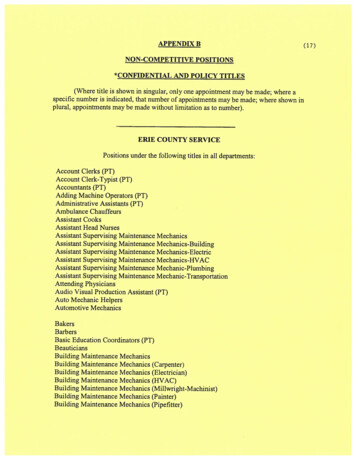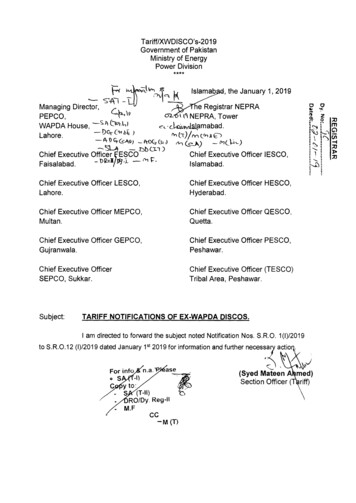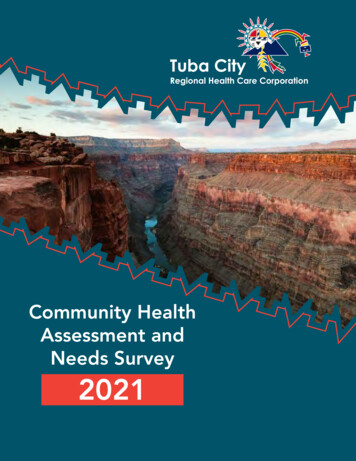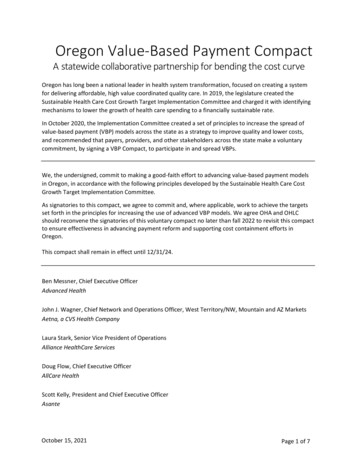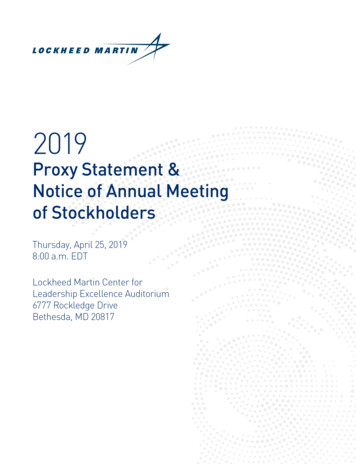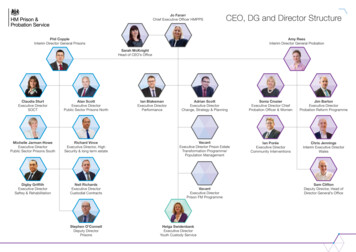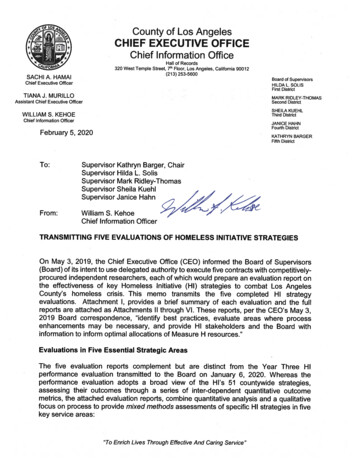
Transcription
County of Los AngelesCHIEF EXECUTIVE OFFICEChief Information OfficeHall of Records320 West Temple Street, 7’ Floor, Los Angeles, California 90012(213) 253-5600SACHI A. HAMAIBoard of SupervisorsHILDA L. SOLISFirst DistrictChief Executive OfficerTIANA J. MURILLOMARK RIDLEY-THOMASSecond DistrictAssistant Chief Executive OfficerSHEILA KUEHLThird DistrictWILLIAM S. KEHOEChief Information OfficerJANICE HAHNFourth DistrictFebruary 5, 2020KATHRYN BARGERFifth DistrictTo:Supervisor Kathryn Barger, ChairSupervisor Hilda L. SolisSupervisor Mark Ridley-ThomasSupervisor Sheila KuehiSupervisor Janice HahnFrom:William S. KehoeChief Information OfficerTRANSMITTING FIVE EVALUATIONS OF HOMELESS INITIATIVE STRATEGIESOn May 3, 2019, the Chief Executive Office (CEO) informed the Board of Supervisors(Board) of its intent to use delegated authority to execute five contracts with competitivelyprocured independent researchers, each of which would prepare an evaluation report onthe effectiveness of key Homeless Initiative (HI) strategies to combat Los AngelesCounty’s homeless crisis. This memo transmits the five completed HI strategyevaluations. Attachment I, provides a brief summary of each evaluation and the fullreports are attached as Attachments II through VI. These reports, per the CEO’s May 3,2019 Board correspondence, “identify best practices, evaluate areas where processenhancements may be necessary, and provide HI stakeholders and the Board withinformation to inform optimal allocations of Measure H resources.”Evaluations in Five Essential Strategic AreasThe five evaluation reports complement but are distinct from the Year Three HIperformance evaluation transmitted to the Board on January 6, 2020. Whereas theperformance evaluation adopts a broad view of the HI’s 51 countywide strategies,assessing their outcomes through a series of inter-dependent quantitative outcomemetrics, the attached evaluation reports, combine quantitative analysis and a qualitativefocus on process to provide mixed methods assessments of specific HI strategies in fivekey service areas:“To Enrich Lives Through Effective And Caring Service”
Each SupervisorFebruary 5, 2020Page 2Five Independent Evaluations of Homeless Initiative Strategies ionEvaluatorCalifornia Policy Lab IUCLAIllOutreachResource DevelopmentAssociatesIVEmergency IInterim HousingHealth anentSupportive HousingWestatD7Al and A5E6B7 and E8Setting a New Standard in the Use of Evidence-Based Analysis to Drive County PolicyThe five attached strategy evaluations, along with the HI Year Three performanceevaluation, together comprise a unified body of inter-related program research that is rarein terms of the collective scope of actionable information being made available toLos Angeles County policymakers and stakeholders. The use of these reports to informcritical deliberations over the allocation of Measure H resources can potentially set a newstandard for evidence-based decision-making in areas identified as policy priorities by theBoard.Next StepsAll five strategy evaluators presented key components of their analyses at the Measure Hpolicy summits convened by the HI from September to November of 2019. With theevaluation reports now complete and transmitted to the Board, the evaluators will eachpresent their findings at meetings of the Homeless Policy Board Deputies in the comingweeks. The analyses presented in these reports, as well as in the HI Year Threeperformance evaluation, will then provide valuable guidance in critical stakeholderdeliberations and budgetary discussions to determine how to optimally allocateMeasure H resources in fiscal year 2020-21 and beyond. Additionally, these evaluationswill inform future modifications to the design and operation of the seven strategies, whichtogether receive the vast majority of Measure H funding.
Each SupervisorFebruary 5, 2020Page 3If you have any questions about the HI strategy evaluations or the Year Threeperformance evaluation, please contact Max Stevens in the Office of theChief Information Officer, at (213) 253-5630 or ntsC:Executive Office, Board of SupervisorsCounty CounselSheriffChildren and Family ServicesHealth ServicesMental HealthProbationPublic HealthPublic Social ServicesLos Angeles Homeless Services Authority
ATTACHMENT IHomeless Initiative Strategy Evaluations OverviewFollowing Transmittal of the Year Three Homeless Initiative (HI) Performance Evaluation to the LosAngeles County Board of Supervisors on January 6, 2020, the Office of the Chief Information Officer is nowreleasing five additional evaluation reports that provide a more detailed examination of specific HIstrategies implemented to combat homelessness. Whereas the Performance Evaluation adopts a broadview of the HI’s 51 countywide strategies, assessing their outcomes through a series of inter-dependentquantitative outcome metrics, the strategy evaluations adopt a mixed methods approach that combinesquantitative analysis and a qualitative focus on process to assess specific HI strategies in four cornerstoneservice areas: PreventionOutreachInterim and Emergency HousingPermanent HousingThe strategy evaluations were conducted by independent analysts engaged through competitiveprocurements. The five reports probe process-related issues as well as outcomes and provide perspectiveon the functionality of the HI strategies and practical details that would be unavailable otherwise. Theanalyses presented in these reports will inform deliberations over Measure H resource allocations andguide efforts to enhance HI strategy performance.PreventionHI Strategies A1 and A5Evaluator:California Policy LabSince 2017, the California Policy Lab at the University of California, Los Angeles (CPL/UCLA) has workedjointly with the HI in using predictive methods to construct data-driven tools and processes toprospectively identify County service users most at risk of becoming homeless. The development of arigorous approach to prioritizing those most likely to experience homelessness in the provision of finitepreventive resource is a critical component of the Lab’s collaborative efforts with the CountyCPL’s evaluation of the HI’s prevention strategies (A1 and A5) leverages the Lab’s familiarity with theCounty’s integrated data resources to produce a rigorous assessment of various approaches tohomelessness prevention. CPL additionally details the steps the County can take to produce the causalevidence needed to enable and guide more aggressive investment in homelessness prevention in thefuture, which include ensuring that those at risk of becoming homeless are connected to social servicesbenefits and streamlining the assessment process.OutreachHI Strategy E6Evaluator:Resource Development AssociatesUnder HI Strategy E6, the Los Angeles Homeless Services Authority (LAHSA) works jointly with the CountyDepartments of Health Services (DHS), Mental Health (DMH), and Public Health (DPH) to develop andadminister an integrated network of street-based outreach that work jointly to route unshelteredindividuals to permanent and interim housing and to connect these persons to supportive services.Resource Development Associates’ (RDA’s) evaluation of the E6 outreach network finds that the strategyimproves the efficiency with which unsheltered persons are matched to services, while also expandingCoordinated Entry System (CES) points of entry in all eight County Service Planning Areas (SPAs). These1
Homeless Initiative Strategy Evaluationsimprovements are closely connected to the development of the Homeless Outreach Portal (LA-HOP), aweb-based tool built under LAHSA’s direction to enhance coordination amongst more than 200 teamscurrently participating in the E6 network. The evaluators note, at the same time, that system-wide qualitymeasures must be established to ensure a consistent deployment of best practices across the network.Interim and Emergency HousingHI Strategies B7 and E8Evaluator:Health Management AssociatesDuring the first two years of Measure H, revenues generated through the quarter-cent sales tax haveenabled a five-fold increase in HI-affiliated IH placements. Evaluation of the HI’s IH strategies is thereforecritical to ensure that the resources committed to this area are oriented towards optimizing opportunities,where appropriate, to transition users of these services into Permanent Housing (PH) arrangements andto otherwise prevent exits from IH to unsheltered homelessness.In assessing HI strategies B7 and E8, Health Management Associates (HMA) cites significant growth inaccess to interim beds and improved coordination between LAHSA, DHS and DMH as important beneficialeffects in this service area. HMA’s report also emphasizes the importance of working to mitigatechallenges staff at IH providers face in serving high-acuity segments of the homeless population, whichcontributes to high rates of staff turnover and can negatively affect the continuity of care so essential tothe likelihood of favorable service outcomes. HMA also notes that resource allocation discussions mustaccount for barriers that often impede transitions to PH among those with acute mental health andSubstance Use Disorder (SUD) challenges.Permanent HousingHI Strategies B3 and D7Evaluator:WestatSecuring exits from homelessness to Permanent Housing, whether via the provision of rental subsidies orby facilitating self-resolution, is the ultimate objective of the homeless services system and fundamentalin determining the success of efforts to reduce homelessness in any setting. The evaluation of PH servicesaffiliated with the HI is divided into two reports both of which are prepared by WestatRapid Re-Housing Evaluation: Strategy B3: One of Westat’s two PH reports focuses on HI Strategy B3, whichseeks to expand Rapid Re-Housing (RRH) services countywide. As reported in the Year Three PerformanceEvaluation, HI-affiliated RRH placements have grown by more than 180% during this period. WhileWestat’s evaluation underscores this capacity increase, as well as improvements in both the durationfrom enrollment to move in and the rates at which clients transition from RRH subsidies to non-timelimited PH arrangements, the report also recommends addressing lengthy RRH stays in advance of thesetransitions, as well as RRH data quality problems, which create difficulties in tracking outcomes andproducing full accounts of the effectiveness of these services.Permanent Supportive Housing Evaluation: Strategy D7: The second of Westat’s two PH reports evaluates theHI’s Permanent Supportive Housing (PSH) strategy (D7). The report credits the strategy with an improvedcapacity to sustain the County’s expanded PSH inventory and reports that D7 has introduced muchneeded flexibility in approaches to funding PSH. Westat describes how D7 intensifies service coordinationbetween PSH personnel at varying levels and locations, but the evaluators also note challenges thatemerge in connection with diverse philosophies guiding the operations of different providers. Providersadditionally report that the infusion of D7 funds comes with an added layer of case management andadministrative responsibilities that at times exacerbate staff burnout and turnover.2
ATTACHMENT IIEvaluation of Los Angeles County Measure H-Funded HomelessnessPrevention StrategiesTill von Wachter, Janey Rountree, Maya Buenaventura, Brian Blackwell, andDean ObermarkCalifornia Policy LabDecember 3, 2019
Table of ContentsExecutive Summary . vAcknowledgements . ix1.Introduction and Background . 1History of A1 and A5 Prevention in Los Angeles County . 2Prevention – Eligibility . 3Homeless Status . 3Income Requirement . 4Targeting Tools. 4Prevention Services: Case Management, Direct Services, and Financial Assistance . 6Case Management and Housing Stabilization Services. 6Housing Identification. 6Rent and Move-in Assistance . 7Other Financial Assistance . 7Legal Services. 7Diversion/Problem-Solving . 11Prevention and Problem-Solving . 12Prior Studies on Homelessness Prevention Programs . 152.Study Overview . 183. Descriptive Analysis: Who is being served by Strategies A1 and A5 and what is theirhousing status after exit? (Research Question 1) . 20Administrative Data Analysis . 20Approach and Data . 20Historical Prevention Trends . 21A1 and A5 Prevention Trends. 22What Happens During Enrollments. 24Prevention Targeting Tool . 27Client Demographics . 33Prior Service Utilization and Homelessness . 35Homelessness After Prevention . 38Pathways . 40Qualitative Data Analysis . 47Approach and Data . 47ii
Service Provider Interviews . 48Legal Service Provider Interviews . 50Family Prevention Focus Group . 534. How could Strategies A1 and A5 be improved and how could scarce prevention fundingbe most efficiently prioritized? (Research Question 2) . 54Correlation between Specific Questions on the Prevention Targeting Tool (PTT) andHousing Outcomes . 55Data and Methodology . 55Can the PTT be Improved? . 62Evaluating the Accuracy of the PTT . 63Data-Driven Methods for Improving the Accuracy and Operational Efficiency of the PTT. 64Results Suggest Potential for Gains in Accuracy and Efficiency. 65Using Predictive Analytics to Efficiently Target Prevention Services . 66Data . 67Prior Homelessness and Homelessness Outcomes for A5 Prevention Clients vs. Risk ListClients . 68Health, Mental Health, and Substance Use Issues amongst Individuals on Risk List . 70Special Considerations for Designing Outreach and Prevention for County ServiceUtilizers at High Risk of Homelessness. 735. Causal Analysis: Does prevention funded through Strategies A1 and A5 directly cause areduction in inflows to homelessness? (Research Question 3) . 74We were unable to identify a comparison group using administrative data . 74Regression Discontinuity Design . 75A causal comparison of prevention participants who received financial assistance withprevention clients who did not receive financial assistance was not plausible . 76Designing a Causal Analysis . 766.Report Summary and Key Takeaways . 78Policy Recommendations . 807.References . 82Appendix A: Problem-Solving Eligibility and Services Offered to Problem-Solving Clients . 85Problem-Solving – Eligibility . 85Homeless Status . 85Income Requirement . 85Problem-solving Services: Case Management and Supportive Services . 85iii
Case Management . 85Financial Assistance . 86iv
Executive SummaryHomelessness prevention programs aim to assist at-risk individuals and familiesmaintain housing stability and reduce the inflows into the homeless services system. In LosAngeles County, the Los Angeles Homeless Services Authority (LAHSA) contracts withhomeless service providers to deliver prevention services to families, single adults, andtransition-age youth who are imminently at-risk of becoming homeless. “Strategy A1”includes homeless prevention programs for families and “Strategy A5” includes homelessprevention programs for single adults and transition-age youth (TAY). In order toimplement prevention under Strategies A1 and A5, LAHSA contracts with homeless serviceproviders to deliver short-term assistance to low-income individuals and families. Serviceproviders then administer a screening survey called the Prevention Targeting Tool (PTT)to determine if clients are experiencing an imminent housing crisis and are eligible forprevention services. Common forms of prevention assistance are short-term financialassistance, housing-conflict resolution and mediation with landlords and/or propertymanagers, housing stabilization planning, and legal assistance. Prevention services areintended to be short-term and are typically provided for up to six months. The goal ofprevention is to secure permanent housing through assisted self-resolution of the housingcrisis (the participant remains in their current housing or relocates, if needed).This evaluation covers Measure H 1-funded LAHSA prevention programs (A1 andA5) for Fiscal Years 2017-18 and 2018-19 (July 1, 2017 to June 30, 2019). We address threeprimary research questions: Research Question 1: Who is being served by Strategies A1 and A5 and what istheir housing status after exit?Research Question 2: How could Strategies A1 and A5 be improved and howcould scarce prevention funding be most efficiently prioritized?Research Question 3: Does prevention funded through Strategies A1 and A5directly cause a reduction in inflows to homelessness?Under Research Question 1, we found that 1,321 single adult households, 1,368family households, and 112 TAY households received prevention services during the studyperiod. Of those, about 74% were given financial assistance to help resolve a housing crisis,including rental assistance and utility arrears. The remainder (26%) were only given casemanagement. Over a third of prevention clients experienced homelessness in the five yearsbefore their enrollment. Sixty-five percent of households are or were CalFresh recipients,and nearly a quarter of households were clients of the Department of Mental Health (DMH)and/or Department of Health Services (DHS). Once clients exited the program, 14.5%returned to homelessness within 12-months. The return rates, however, were verydifferent for households who received financial assistance (5.3%) compared to those thatIn response to the homelessness crisis, voters in Los Angeles County passed Measure H, whichincreases taxes to add an estimated 355 million for homeless services each year.1v
did not (19.9%). Finally, we examined clients’ pathways into and out of preventionservices. Nearly half of households who enrolled in prevention move from a doubled-uphousing situation with family or friends to an unsubsidized rental. 2We supplemented the quantitative analysis under Research Question 1 with semistructured interviews with prevention service providers and legal service providers to geta more complete picture of who is being served by Strategies A1 and A5 and how serviceproviders screen individuals and families and administer prevention services. Ourinterviews show service providers have a generally positive view of A1 and A5 preventionefforts. Providers most frequently pointed to rental arrears or rental assistance as the mostbeneficial program component, though we also observed frequent usage and widespreadsupport for legal services. Service providers found the prevention program model to berelatively clear, but indicated confusion regarding problem-solving and its role inconjunction with prevention. Providers reported using the Prevention Targeting Tool(PTT) consistently, though that wasn’t entirely supported by the administrative data. Legalservice providers recommended closer coordination with homeless service providers,including co-location, regularly-scheduled and in-depth case conferences, more swiftreferrals, training service provider staff to better spot legal issues (or hiring an attorney onstaff to spot legal issues), and expanding the universe of organizations permitted to makelegal referrals.Under Research Question 2, we identify potential ways to improve theprioritization and efficiency of prevention resources. We found that the accuracy andefficiency of the PTT screening tool could be improved by re-weighting the tool andeliminating certain questions. On average, reweighting and simplification could increasethe accuracy between 8% and 34%, while at the same time reducing the number ofquestions from 30 to 13 for the Families PTT and from 30 to 12 for the Individuals PTT.Since the PTT is a relatively new survey, we performed our analyses on relatively smalldatasets with positive responses to many questions being rare. As a result, it may bepremature to shorten the survey based on our analysis. Instead, we recommended thatLAHSA engage in a policy planning process to shorten the survey and then empiricallyvalidate the PTT by continuing to collect data and engaging in a continuous improvementprocess.We also include an analysis of an underserved population of individuals who are athigh-risk of homelessness under Research Question 2. Notably, the targeting mechanismfor existing A1 and A5 prevention services is largely driven by client self-identification (i.e.,clients must seek assistance from a prevention service provider), with further screeningtaking place via the PTT and related eligibility criteria. This raises the question, however, ofwhether there are potential clients who are unaware of prevention services or are unableor unwilling to present themselves as being at-risk, who could potentially be identified andThis statistic only includes households for whom enough time has passed to complete a 6-monthenrollment in prevention, i.e., households who enrolled at least 6 months prior to the drafting of this report.2vi
served. The use of predictive analytics – a field that applies statistical and machine learningmethods to administrative data in order to predict future outcomes – provides anopportunity to identify such high-risk, underserved populations. In an effort separate frombut related to this evaluation, the California Policy Lab, in partnership with University ofChicago Urban Labs, has been working with the Los Angeles County Chief InformationOffice and Homeless Initiative to develop a model for predicting homelessness amongstsingle adults who utilize County services. 3 The lists of high-risk individuals identified bythe predictive models can be used for proactive outreach. In other words, rather thanwaiting for clients to self-identify and present themselves to a service provider as being atrisk, as is the case with existing prevention strategies, caseworkers at County agencies orLAHSA service providers could proactively contact clients on the predicted risk list.We compared the single adults predicted by the models to be at highest risk ofhomelessness with the clients actually served by A5 prevention services. (There were5,556 individuals identified by the predictive models and 1,266 A5 prevention clients inFiscal Years 2017-18 and 2018-19.) We found that only 23 individuals across Fiscal Years2017-18 and 2018-19 were both identified by the predictive models and enrolled in an A5prevention project. This should not be taken to suggest that clients served by A5prevention services are not at high risk of homelessness. More likely, these populations areboth at high risk of homelessness but are identified in different ways and should be servedat different intervention points. Specifically, the group identified by the model appears tobe disconnected from homelessness prevention resources.Under Research Question 3, we sought to estimate whether prevention is directlycausing reductions in inflows to homelessness. This type of analysis explores what wouldhave happened to prevention clients if they hadn’t been served: Would they havesuccessfully self-resolved their housing crisis or would they have fallen into homelessness?One of the ways that researchers estimate what would have happened to individuals orfamilies if they had not participated in a program is by identifying individuals and familieswho are very similar to program participants but who did not participate in the program,i.e., “comparison” or “control” individuals and families. By comparing the outcomes of acomparison group with the outcomes of the program participants, researchers can get anidea of what would have happened to program participants if they had not participated inthe program. In the case of homelessness prevention, all program participants were atimminent risk of losing their housing. Thus, when identifying individuals and families whocould serve as comparison individuals, it was important to try to find individuals andfamilies who were also at imminent risk of losing their housing (but who did not receiveprevention services). Although the ELP data and HMIS data contains demographicinformation and service utilization information on
On May 3, 2019, the Chief Executive Office (CEO) informed the Board of Supervisors (Board) of its intent to use delegated authority to execute five contracts with competitively-procured independent researchers, each of which would prepare an evaluation report on the effectiveness of key Homeless Initiative (HI) strategies to combat Los Angeles
